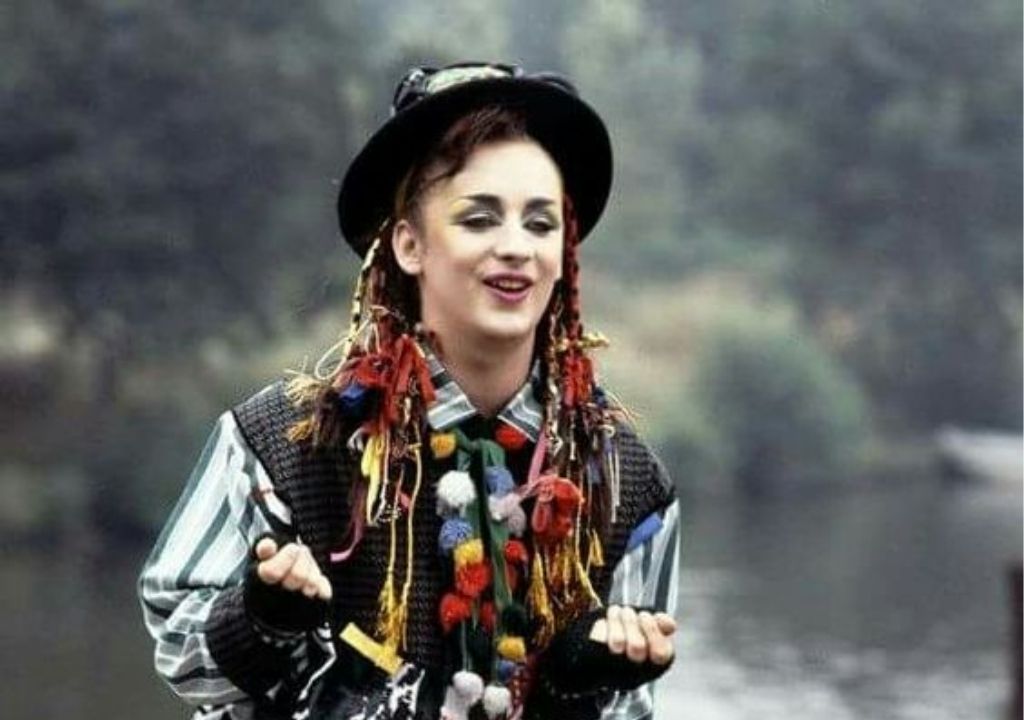About the song
“Karma Chameleon” is one of the most iconic and successful songs by the British band Culture Club, released as the lead single from their second album, Colour by Numbers (1983). Written by the band’s lead singer Boy George (born George O’Dowd), along with keyboardist Mikey Craig and guitarist Roy Hay, the song became a global smash hit, achieving significant commercial success and cementing the band’s place in pop music history.
Musical Style and Themes:
“Karma Chameleon” is characterized by its catchy melody, upbeat rhythm, and distinctive blend of new wave, pop, and reggae influences. The song features bright, infectious instrumentation, including jangly guitars, a bouncy bassline, and a memorable horn section that adds to its lively, feel-good atmosphere. The music’s upbeat tempo and vibrant arrangement make it a perfect dance anthem, while Boy George’s unique vocal style gives the track a memorable, signature sound.
Lyrically, “Karma Chameleon” is about the complexity and unpredictability of relationships. The song’s narrator speaks of someone who is emotionally fickle, constantly changing their feelings and behavior, much like a chameleon changes its color. Boy George uses the metaphor of the chameleon to describe the person’s tendency to adapt or hide their true self depending on the situation, leading to feelings of confusion and frustration. The lyrics touch on the idea of love and trust, with the narrator seeking someone who is genuine and reliable. However, the song also conveys a sense of acceptance and playful irony, with the catchy chorus (“I’m a man without conviction / I’m a man who doesn’t know / How to sell a contradiction”) adding to the lighthearted yet introspective tone of the song.
The phrase “karma chameleon” in the chorus is a clever wordplay, with “karma” referring to the concept of fate or destiny in Eastern philosophy, and “chameleon” symbolizing changeability. The song suggests that the person being described may be a product of their own karma, constantly shifting and evolving without stability or consistency.
Chart Success and Reception:
“Karma Chameleon” became Culture Club’s biggest hit, reaching the number one spot on the charts in multiple countries around the world. In the United States, it topped the Billboard Hot 100 for three consecutive weeks in 1984, making it one of the most successful songs of the year. It also reached number one in the United Kingdom, Canada, and many other countries, solidifying the band’s international fame.
Critics praised the song for its catchy, accessible sound and for Boy George’s distinctive vocal delivery, which blended vulnerability with a sense of swagger. The song’s upbeat vibe and infectious chorus made it a favorite on the radio and in dance clubs, helping Culture Club become one of the most popular bands of the early 1980s.
Music Video:
The music video for “Karma Chameleon” is just as colorful and playful as the song itself. Directed by David Bailey, the video features Boy George and the band in a variety of vibrant, stylized settings, reflecting the song’s upbeat, fun energy. Boy George is dressed in a flamboyant, colorful outfit, which became an iconic look for him during the 1980s, and the video also features scenes of the band performing in front of a backdrop of lush, tropical scenery. The visual style of the video is playful and full of personality, with Boy George’s androgynous style and bold fashion choices becoming a defining characteristic of the band’s image at the time.
The video helped further establish Boy George as a cultural icon, known for his gender-fluid fashion and eccentric style. His look, which often included elaborate makeup and outlandish costumes, contributed to his reputation as an outspoken figure in the LGBTQ+ community and in the broader pop culture landscape.
Legacy:
“Karma Chameleon” remains one of Culture Club’s signature songs and is often regarded as one of the most memorable pop songs of the 1980s. The song’s universal themes of love, change, and emotional conflict, combined with its infectious melody, have made it a timeless classic. It continues to be a crowd favorite at concerts, nostalgic 80s events, and pop music playlists.
The song is also recognized for its cultural impact in the 1980s, a time when the music scene was rapidly changing and becoming more diverse. Boy George’s unapologetic individuality and gender-bending fashion choices made a lasting impression on popular culture, and “Karma Chameleon” became emblematic of this new wave of artists who embraced self-expression and challenged traditional norms.
Moreover, the song helped cement Culture Club’s place in the broader New Romantic movement, a musical and fashion-oriented subculture that emerged in the early 1980s, which celebrated bold visual aesthetics and eclectic musical styles. “Karma Chameleon” is often viewed as a crossover hit that introduced the band to mainstream pop audiences, leading to the success of their entire Colour by Numbers album.
Cultural Impact and Performances:
The legacy of “Karma Chameleon” has endured over the decades. The song has been covered by various artists, featured in commercials, movies, and television shows, and has been embraced by new generations of fans. It is frequently included in “best of” 80s music compilations and continues to be a staple in 80s-themed events and radio stations.
Culture Club performed “Karma Chameleon” at major events and award shows, and the song is often a highlight of their live performances. The band’s ability to blend pop, new wave, and reggae influences made them stand out from their contemporaries, and “Karma Chameleon” remains their most commercially successful and enduring track.
In summary, “Karma Chameleon” is a landmark song in the history of 80s pop music, beloved for its infectious melody, clever lyrics, and vibrant cultural significance. It encapsulates the spirit of the era while continuing to resonate with listeners for its universal themes of love, change, and the complexities of human relationships.
